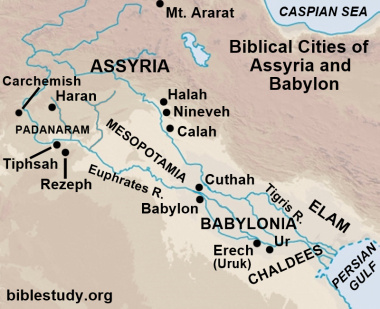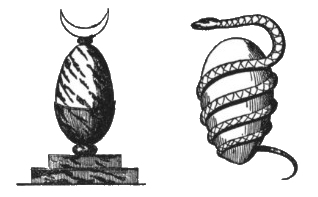The word Easter is not Christian. It bears its Chaldean (Chaldees) origin on its very forehead. It is nothing else than Astarte, one of the titles of Beltis, the queen of heaven, whose name, as pronounced by the people of Nineveh, was evidently identical with that which is now in common use. That name, found on the Assyrian monuments, is Ishtar.
The worship of Bel and Astarte (the early form of Easter) was very early introduced into Britain, along with the Druids, "the priests of the groves." Some have imagined that the Druidical worship was first introduced by the Phoenicians, who, centuries before the Christian era, traded to the tin mines of Cornwall. That said, the unequivocal traces of that worship are found in regions of the British islands where the Phoenicians never penetrated, and it has everywhere left indelible marks of the strong hold that it must have had on the early British mind.
If Baal was thus worshipped in Britain, it will not be difficult to believe that his consort Astarte (Ishtar) was also adored by our ancestors. It is from the worship of Astarte and the corresponding religious solemnities that took place in April that we derive the festival we now call Easter.

where Easter originated
The festival, of which we read in Church history, under the name of Easter, in the third or fourth centuries, was quite a different festival from that now observed in the Romish (Catholic) Church, and at that time was not known by such a name. It was called Pasch, or the Passover, and was very early observed by many professing Christians, in commemoration of the sacrifice of Christ.
The festival of Passover was not idolatrous, and it was preceded by no Lent. "It ought to be known," said Cassianus, the monk of Marseilles, writing in the fifth century, and contrasting the primitive Church with the Church in his day, "that the observance of the forty days (of Lent) had no existence, so long as the perfection of that primitive Church remained inviolate."
The change of the calendar from observing the Biblical Passover to Easter Sunday (as well as Palm Sunday and Good Friday) was attended with momentous consequences. It brought into the Church the grossest corruption and the rankest superstition in connection with the abstinence of Lent. That Christians should ever think of introducing the Pagan abstinence of Lent was a sign of evil; it showed how low they had sunk, and it was also a cause of evil; it inevitably led to deeper degradation.
Hot Cross Buns
The popular observances that still attend the celebration of Easter amply confirm the testimony of history as to its Babylonian character.
The hot cross buns of Good Friday, and the dyed eggs of Easter Sunday, figured in the Chaldean rites just as they do now. The "buns," known too by that identical name, were used in the worship of the queen of heaven, the goddess Easter, as early as the days of the founding of Athens -- that is, 1,500 years before the Christian era.
"One species of sacred bread," says Bryant, "which used to be offered to the gods, was of great antiquity, and called Boun." Diogenes Laertius, speaking of this offering being made by Empedocles, describes the chief ingredients of which it was composed, saying, "He offered one of the sacred cakes called Boun, which was made of fine flour and honey." The prophet Jeremiah takes notice of this offering when he says the following.
"Do you not see what they do in the cities of Judah and in the streets of Jerusalem?
"The children gather wood, and the fathers kindle the fire, and the women knead dough, to make cakes to the queen of heaven and to pour out drink offerings to other gods, that they may provoke Me to anger . . .
"Therefore thus says the Lord God; "Behold, My anger and My fury shall be poured out on this place . . ."" (Jeremiah 7:17 - 18, 20, HBFV throughout).
The hot cross buns are not now offered, but eaten, on the festival of Astarte; but this leaves no doubt as to whence they have been derived.
Easter Eggs
The origin of Easter eggs in history is just as clear. The ancient Druids bore an egg, as the sacred emblem of their order. In the mysteries of Bacchus, as celebrated in Athens, one part of the nocturnal ceremony consisted in the consecration of an egg. The Hindu fables celebrate their mundane egg as of a golden color.
The people of Japan make their sacred egg to have been brazen. In China, dyed or painted eggs are used on sacred festivals. In ancient times, eggs were used in the religious rites of the Egyptians and the Greeks, and were hung up for mystic purposes in their temples.

Typhon's Egg (right)
From Egypt, these sacred eggs can be distinctly traced to the banks of the Euphrates. The classic poets are full of the fable of the mystic egg of the Babylonians. A tale is told by Hyginus, the Egyptian, the learned keeper of the Palatine library at Rome, in the time of Augustus, who was skilled in all the wisdom of his native country, who wrote the following.
"An egg of wondrous size is said to have fallen from heaven into the river Euphrates. The fishes rolled it to the bank, where the doves having settled upon it, and hatched it, out came Venus, who afterwards was called the Syrian Goddess (Astarte)"
The egg became one of the symbols of Astarte or Easter; and accordingly, in Cyprus, one of the chosen seats of the worship of Venus, or Astarte, the egg of wondrous size was represented on a grand scale.
The occult meaning of this mystic egg of Astarte, in one of its aspects, had reference to the ark during the time of the flood, in which the whole human race were shut up, as the chick is enclosed in the egg before it is hatched.
The Sacred Egg
The sacred egg of paganism, as already indicated, is well known as the "mundane egg," that is, the egg in which the world was shut up. Now the "world" has two distinct meanings. It means either the material earth, or the inhabitants of the earth. The latter meaning of the term is seen in Genesis 11:1, "And the whole earth was of one language and one speech" where the meaning is that the whole people of the world were so.
If then the world is seen shut up in an egg that floats on water, it may not be difficult to believe that the egg thus floating on the wide universal sea might be Noah's family that contained the whole world in its bosom.
The coming of the egg from heaven evidently refers to the preparation of the ark by express appointment of God; and the same thing seems clearly implied in the Egyptian story of the mundane egg which was said to have come out of the mouth of the great god. The doves resting on the egg need no explanation. This, then, was the meaning of the mystic egg in one aspect.
The Queen of Heaven
As, however, everything that was good or beneficial to mankind was represented in the Chaldean mysteries, as in some way connected with the Babylonian goddess, so the greatest blessing to the human race, which the ark contained in its bosom, was held to be Astarte, who was the great civilizer and benefactor of the world.
The deified queen of heaven, whom Astarte represented, had no actual existence until some centuries after the flood. However, through the doctrine of metempsychosis, which was firmly established in Babylon, it was easy for her worshippers to be made to believe that, in a previous incarnation, she had lived in the Antediluvian world, and passed in safety through the waters of the flood. Now the Romish (Catholic) Church adopted this mystic egg of Astarte, and consecrated it as a symbol of Christ's resurrection.
The Real History!
The 1913 Catholic Encyclopedia, in its article on Easter, openly admits that symbols like eggs and rabbits (bunnies represent fertility), used to celebrate the holiday, are NOT based on the Bible! They were "borrowed" from ancient customs pagans used to worship their false deities and adapted by the church for its own purposes.
"The symbolic meaning of a new creation of mankind by Jesus risen from the dead was probably an invention of later times. The custom may have its origin in paganism, for A GREAT MANY PAGAN CUSTOMS, celebrating the return of spring, gravitated to Easter . . .
"The Easter Rabbit lays the eggs, for which reason they are hidden in a nest or in the garden. The rabbit is a PAGAN SYMBOL and has always been an emblem of fertility."
As Rome cherishes the same feelings as paganism did, so it has adopted the very same symbols, so far as it has the opportunity. This is the real history of Easter and its symbols!